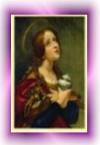The great artist Auguste Rodin, who sculpted “The Thinker” and other world famous pieces, met today’s saint in 1862 and joined his Congregation as a lay brother. Rodin was despondent over the death of his sister and wanted to abandon art and dedicate his life to God. Saint Peter Julian Eymard burned like a bonfire for God, but this was one vocation his flames would not consume. Father Eymard could see Rodin’s prodigious talent in an evocative bust Rodin sculpted of the future saint while he was a religious brother. Eymard told Rodin to return to the world to pursue his artistic calling. So while Father Eymard was as apostolic and demanding as any saint, he was also just as wise as any saint. Not every man who felt a vocation truly had one. It was for the superior to discern the validity of the calling. Father Eymard knew this well from personal experience. He had lived at least three priesthoods inside of his one priesthood: as a diocesan priest in a parish, as a religious priest in the Marist Order, and as the founder of the Congregation of the Most Blessed Sacrament.
There was never a time when Peter Julian Eymard did not love Christ in the Blessed Sacrament. At the age of five, he disappeared from home one day. His siblings went in search and found him standing right next to the tabernacle in their local church. When they asked him what he was doing there, little Peter responded, “I am here listening to Jesus.” His father did not want Peter to be a priest but a blacksmith. He relented a bit over time and then died prematurely, removing all opposition. Peter was ordained a diocesan priest in 1834 and served in a parish. But he felt a slightly different call within his call and began to seek admission to the Society of Mary, or Marists. His diocesan bishop was reluctant to let Father Peter go. The bishop relented in 1839, writing to the Marist superior that “I have given sufficient proof of my high esteem for the Society of Mary in giving it such a priest.”
Father Peter’s personal energy, apostolic zeal, and prayerfulness led to his being named a Marist Provincial. He traveled throughout France and became acquainted with nocturnal and perpetual adoration societies. He became expert at preaching about the Eucharist and at directing lay Eucharistic societies. During a Corpus Christi procession in 1845 he had a mystical experience while carrying the Blessed Sacrament. His attraction to the Eucharist became so personal and so intense that he resolved “to preach nothing but Jesus Christ, and Jesus Christ Eucharistic” from then on. Discussions with his superiors about orienting the Marist’s more toward a Eucharistic identity were frustrated. It was not their primary charism. On January 21, 1851, at the Shrine of Our Lady of Fourviere overlooking Lyon, Father Eymard received the inspiration to found a new Order dedicated exclusively to the Blessed Sacrament. This third call within his one priestly call would consume the rest of his life.
In 1857 the Society of the Blessed Sacrament was formally established in Paris. One year later, the Servants of the Blessed Sacrament for nuns would be founded. Father Peter and his few companions did not limit their Eucharistic dedication to piety and prayer. They prepared children to receive First Holy Communion, reached out to lapsed Catholics, and promoted frequent reception of Holy Communion for all Catholics. The normal struggles of every young Congregation bedeviled Father Eymard: extreme poverty, atrocious lodgings, lack of vocations, and problems of growth.
Rodin’s bust captures the essence of Father Eymard better than any photo. Eymard’s mass of hair is out of control, communicating his passionate eccentricity. His gaze is penetrating. He knows the mysteries of God and other secrets of the soul. His thin face, straight nose, and protruding cheekbones say he is a mortified ascetic. And buried in his vest, just over his heart, is a scroll. Only a few words of it can be read. It is a fragment of Emyard’s prayer: “O Sacrament Most Holy, O Sacrament Divine, all praise and all thanksgiving be every moment thine.” His love of the Eucharist pulsated in sync with his heart, every moment of every day of his fifty-seven years. Our saint is buried in his Congregation’s chapel in Paris. He was canonized in 1962 and in 1995 his Optional Memorial was finally included in the Church’s universal sanctoral calendar.
First class relic of St. Eymard given to Fr. Paul from JuneD
August 2nd St Peter Julian Eymard
Moderators: Johnna, MarieT, Denise, KarlB
August 2nd St Peter Julian Eymard
Devotion to the souls in Purgatory contains in itself all the works of mercy, which supernaturalized by a spirit of faith, should merit us Heaven. de Sales
